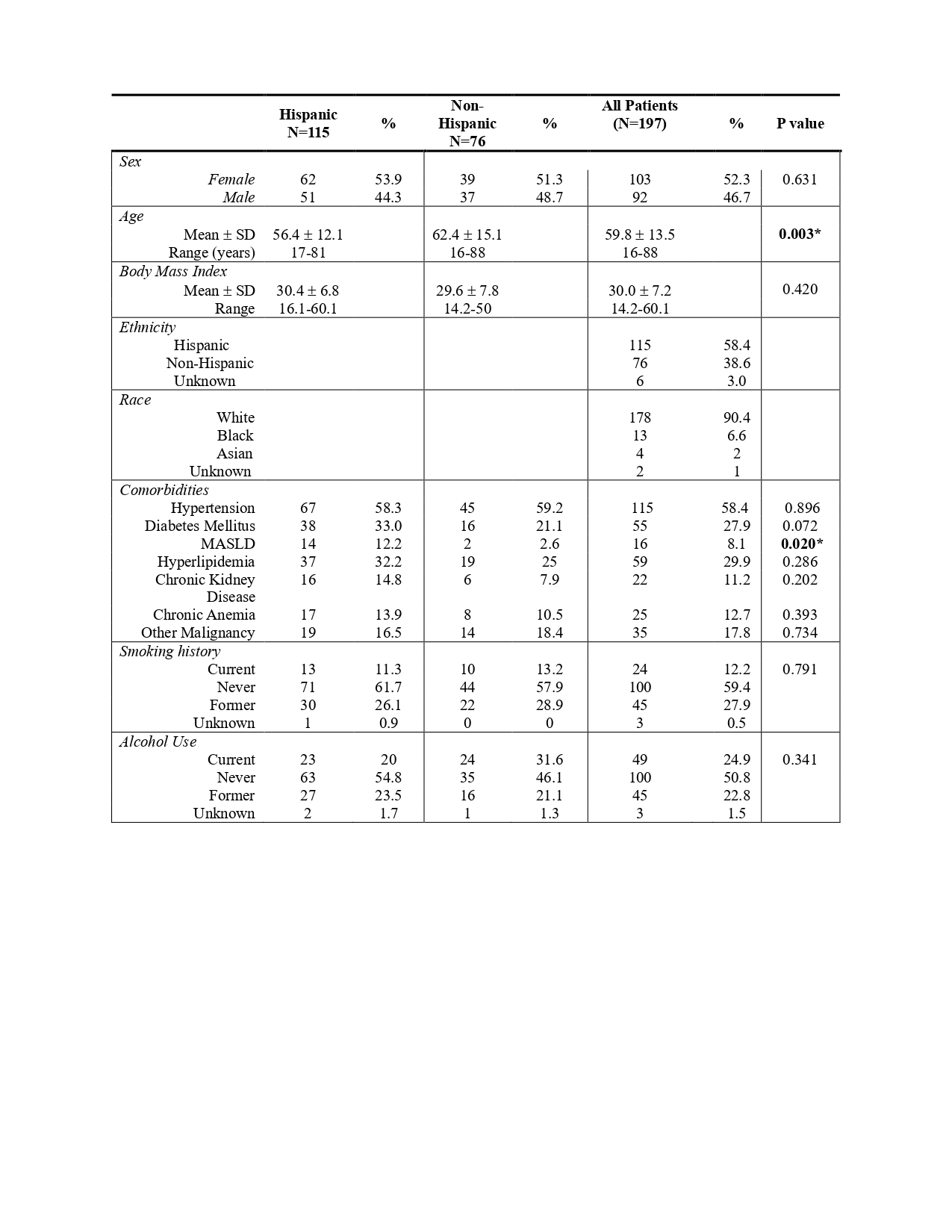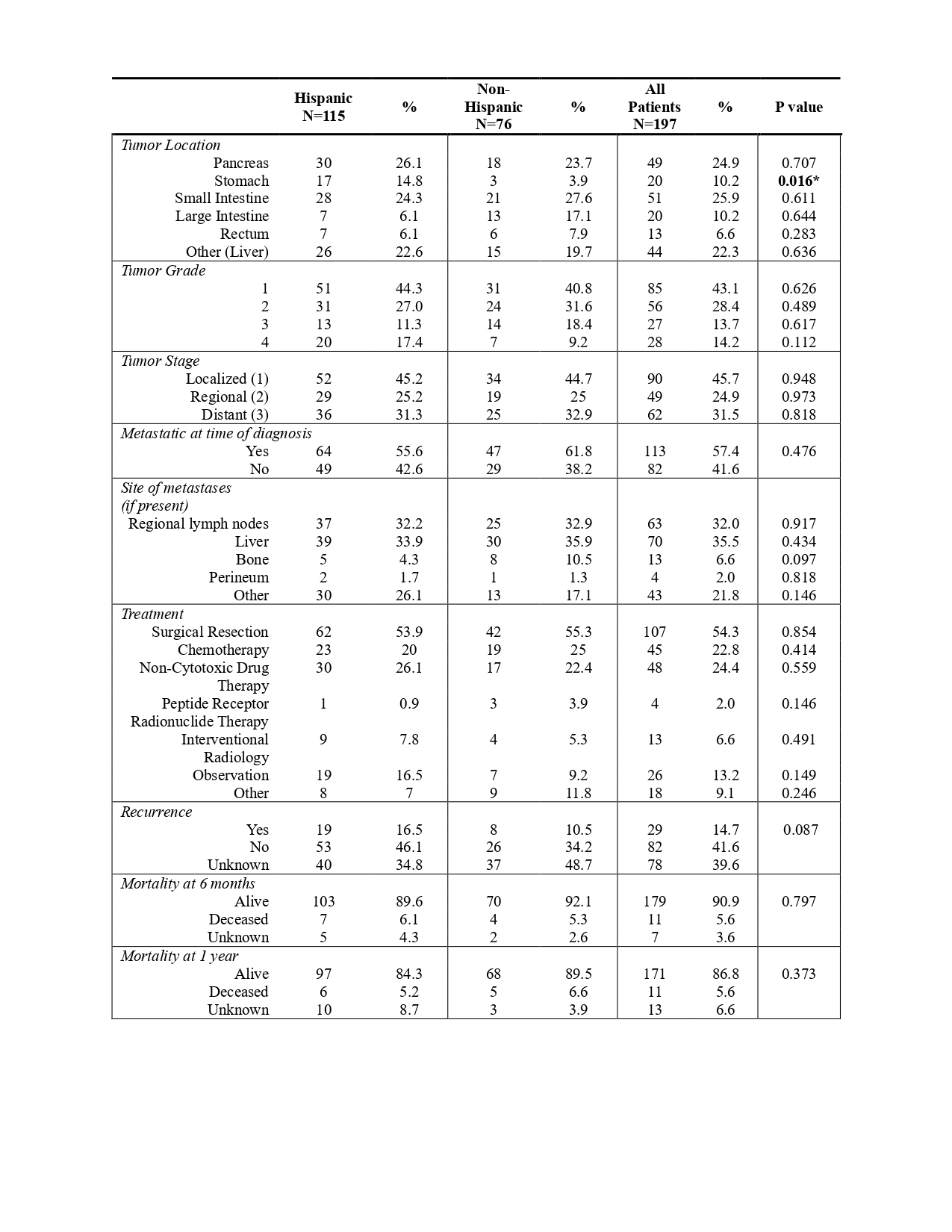Monday Poster Session
Category: Small Intestine
P4054 - Nothing but NET: Characterization of Gastroenteropancreatic Neuroendocrine Tumors in a South Texas Population
Monday, October 27, 2025
10:30 AM - 4:00 PM PDT
Location: Exhibit Hall

Keerthi Thallapureddy, MD (she/her/hers)
University of Texas Health San Antonio
Temple, TX
Presenting Author(s)
Keerthi Thallapureddy, MD1, Leen Azeez, MD2, Adam Vinall, MD2, Grecia Dominguez Rivera, MD2, Chioma Owo, MD2, Daniel Nyancho, MD, BS3, Sukeshi P. Arora, MD4, Laura Rosenkranz, MD2
1University of Texas Health San Antonio, Temple, TX; 2University of Texas Health San Antonio, San Antonio, TX; 3University of Texas Health San Antonio, Cleveland, OH; 4Mays Cancer Center, UT Health San Antonio, San Antonio, TX
Introduction: The incidence of gastroenteropancreatic neuroendocrine neoplasms (GEP-NENs) has increased over time with an age-adjusted rate of 7 per 100,000 persons in the U.S. as reported in 2012. Surveillance, Epidemiology and End Results (SEER) and the Veteran Affairs cancer databases have explored epidemiologic features of GEP-NENs. This observational study characterizes the demographics and characteristics of GEP-NENs at a large single academic center in South Texas.
Methods: A query of ICD codes for GEP-NENs of adult patients diagnosed between 2018 and 2024 was followed by analysis of demographics, comorbidities, smoking and alcohol use, tumor characteristics, treatments and outcomes. SPSS was utilized for statistical analysis.
Results: 197 patients, mean age 59.8 ± 13.6 years with female predominance over males (52.3% vs. 47.2%) were included in the analysis (Table 1). Race distribution was White (90.4%), Black (6.6%), and Asian (2%), with Hispanic ethnicity being most prevalent (58.4%). Hypertension (58.4%), Hyperlipidemia (29.9%) and Type 2 Diabetes Mellitus (27.9%) were identified as most prevalent comorbidities. 40.1% and 47.7 % had a history of smoking and alcohol use, respectively. 8.1% had metabolic associated steatotic liver disease (MASLD). Tumor location distribution was small intestine (25.9%), pancreas (24.9%), liver (22.3%), and stomach (10.2%). Most tumors were grade 1 15/197 (43.1%) at time of diagnosis. 113/197 (57.4%) were metastatic, most commonly to the liver (35.3%) and regional lymph nodes (32.0%). The most common treatment options pursued included surgical resection (54.3%), followed by non-cytotoxic drug therapy (24.4%) and chemotherapy (22.8%). Recurrence was observed in 14.7% of patients, and the mortality rate at both 6 months and 1 year was noted to be 5.6%.
Discussion: Our study showed a slightly higher proportion of female patients and a notably greater representation of Hispanics compared to SEER data (15%). Most patients presented with localized or low-grade disease, yet over half had metastases at diagnosis. Surgical resection remains the most common treatment and outcomes were favorable with low risk of recurrence and low short-term mortality, compared to SEER 1-year survival (74.8%). Hispanics were more likely to be diagnosed at a younger age (p=0.003), exhibit a higher prevalence of MASLD (p=0.020), and show a greater incidence of primary tumors localized in the stomach (p=0.016). Future studies should study prognostic markers in this Hispanic-rich cohort.

Figure: Table 1. Demographic characteristics with frequency and percentage (%) of comorbidities (hypertension, hyperlipidemia, diabetes mellitus, chronic anemia, chronic kidney disease, metabolic associated steatotic liver disease (MASLD) and the presence of other malignancies) as well as history of smoking and alcohol use (never, former, current and unknown). * indicates p value <0.05.

Figure: Table 2. Characteristics of GEP-NENs including tumor location, grade and stage, presence of metastasis at time of diagnosis, site of metastases if present, treatment pursued (surgical resection, chemotherapy, non-cytotoxic drug therapy, peptide receptor radionuclide therapy (PRRT), interventional radiology, observation and other), recurrence as well as mortality at 6 months and 1 year following diagnosis.
Disclosures:
Keerthi Thallapureddy indicated no relevant financial relationships.
Leen Azeez indicated no relevant financial relationships.
Adam Vinall indicated no relevant financial relationships.
Grecia Dominguez Rivera indicated no relevant financial relationships.
Chioma Owo indicated no relevant financial relationships.
Daniel Nyancho indicated no relevant financial relationships.
Sukeshi Arora: AstraZeneca – Advisory Committee/Board Member, Speakers Bureau. Bristol Meyers Squibb – Advisory Committee/Board Member, Speakers Bureau. Exelixis – Advisory Committee/Board Member, Speakers Bureau. Pfizer – Advisory Committee/Board Member, Speakers Bureau. Tempus – Advisor or Review Panel Member.
Laura Rosenkranz indicated no relevant financial relationships.
Keerthi Thallapureddy, MD1, Leen Azeez, MD2, Adam Vinall, MD2, Grecia Dominguez Rivera, MD2, Chioma Owo, MD2, Daniel Nyancho, MD, BS3, Sukeshi P. Arora, MD4, Laura Rosenkranz, MD2. P4054 - Nothing but NET: Characterization of Gastroenteropancreatic Neuroendocrine Tumors in a South Texas Population, ACG 2025 Annual Scientific Meeting Abstracts. Phoenix, AZ: American College of Gastroenterology.
1University of Texas Health San Antonio, Temple, TX; 2University of Texas Health San Antonio, San Antonio, TX; 3University of Texas Health San Antonio, Cleveland, OH; 4Mays Cancer Center, UT Health San Antonio, San Antonio, TX
Introduction: The incidence of gastroenteropancreatic neuroendocrine neoplasms (GEP-NENs) has increased over time with an age-adjusted rate of 7 per 100,000 persons in the U.S. as reported in 2012. Surveillance, Epidemiology and End Results (SEER) and the Veteran Affairs cancer databases have explored epidemiologic features of GEP-NENs. This observational study characterizes the demographics and characteristics of GEP-NENs at a large single academic center in South Texas.
Methods: A query of ICD codes for GEP-NENs of adult patients diagnosed between 2018 and 2024 was followed by analysis of demographics, comorbidities, smoking and alcohol use, tumor characteristics, treatments and outcomes. SPSS was utilized for statistical analysis.
Results: 197 patients, mean age 59.8 ± 13.6 years with female predominance over males (52.3% vs. 47.2%) were included in the analysis (Table 1). Race distribution was White (90.4%), Black (6.6%), and Asian (2%), with Hispanic ethnicity being most prevalent (58.4%). Hypertension (58.4%), Hyperlipidemia (29.9%) and Type 2 Diabetes Mellitus (27.9%) were identified as most prevalent comorbidities. 40.1% and 47.7 % had a history of smoking and alcohol use, respectively. 8.1% had metabolic associated steatotic liver disease (MASLD). Tumor location distribution was small intestine (25.9%), pancreas (24.9%), liver (22.3%), and stomach (10.2%). Most tumors were grade 1 15/197 (43.1%) at time of diagnosis. 113/197 (57.4%) were metastatic, most commonly to the liver (35.3%) and regional lymph nodes (32.0%). The most common treatment options pursued included surgical resection (54.3%), followed by non-cytotoxic drug therapy (24.4%) and chemotherapy (22.8%). Recurrence was observed in 14.7% of patients, and the mortality rate at both 6 months and 1 year was noted to be 5.6%.
Discussion: Our study showed a slightly higher proportion of female patients and a notably greater representation of Hispanics compared to SEER data (15%). Most patients presented with localized or low-grade disease, yet over half had metastases at diagnosis. Surgical resection remains the most common treatment and outcomes were favorable with low risk of recurrence and low short-term mortality, compared to SEER 1-year survival (74.8%). Hispanics were more likely to be diagnosed at a younger age (p=0.003), exhibit a higher prevalence of MASLD (p=0.020), and show a greater incidence of primary tumors localized in the stomach (p=0.016). Future studies should study prognostic markers in this Hispanic-rich cohort.

Figure: Table 1. Demographic characteristics with frequency and percentage (%) of comorbidities (hypertension, hyperlipidemia, diabetes mellitus, chronic anemia, chronic kidney disease, metabolic associated steatotic liver disease (MASLD) and the presence of other malignancies) as well as history of smoking and alcohol use (never, former, current and unknown). * indicates p value <0.05.

Figure: Table 2. Characteristics of GEP-NENs including tumor location, grade and stage, presence of metastasis at time of diagnosis, site of metastases if present, treatment pursued (surgical resection, chemotherapy, non-cytotoxic drug therapy, peptide receptor radionuclide therapy (PRRT), interventional radiology, observation and other), recurrence as well as mortality at 6 months and 1 year following diagnosis.
Disclosures:
Keerthi Thallapureddy indicated no relevant financial relationships.
Leen Azeez indicated no relevant financial relationships.
Adam Vinall indicated no relevant financial relationships.
Grecia Dominguez Rivera indicated no relevant financial relationships.
Chioma Owo indicated no relevant financial relationships.
Daniel Nyancho indicated no relevant financial relationships.
Sukeshi Arora: AstraZeneca – Advisory Committee/Board Member, Speakers Bureau. Bristol Meyers Squibb – Advisory Committee/Board Member, Speakers Bureau. Exelixis – Advisory Committee/Board Member, Speakers Bureau. Pfizer – Advisory Committee/Board Member, Speakers Bureau. Tempus – Advisor or Review Panel Member.
Laura Rosenkranz indicated no relevant financial relationships.
Keerthi Thallapureddy, MD1, Leen Azeez, MD2, Adam Vinall, MD2, Grecia Dominguez Rivera, MD2, Chioma Owo, MD2, Daniel Nyancho, MD, BS3, Sukeshi P. Arora, MD4, Laura Rosenkranz, MD2. P4054 - Nothing but NET: Characterization of Gastroenteropancreatic Neuroendocrine Tumors in a South Texas Population, ACG 2025 Annual Scientific Meeting Abstracts. Phoenix, AZ: American College of Gastroenterology.

